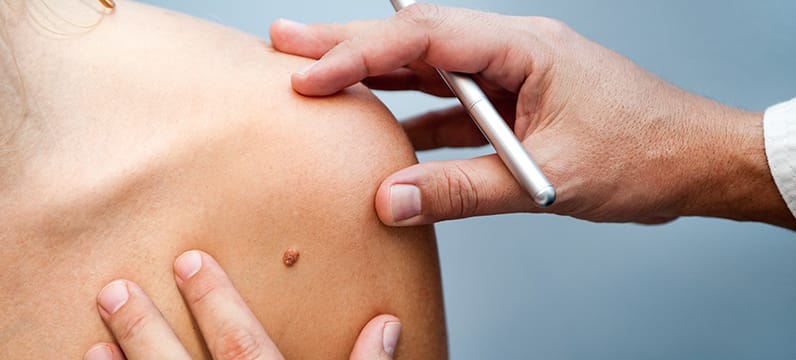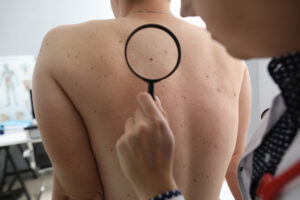Mole Check & Mole Removal in South Miami
What is a mole?
A mole refers to a skin growth, usually black or brown in color, which can appear anywhere on your skin. Usually, a mole will appear during a person’s childhood but could change shape or color as you get older. In some cases, moles might completely disappear over time. In some cases, a mole changing might indicate a skin problem, including skin cancer. It is important to visit a certified dermatologist, such as the experts at the Skin Center of South Miami, if you have moles or notice a mole changing over time.
What causes moles?
Moles are usually the result of skin cell growth in a cluster rather than spread out within the skin. When these cells are first formed, they are usually the normal color of your skin. However, over the course of your life, exposure to the sun and aging will usually turn the area a darker, more noticeable color.
How to tell if your Mole is Cancerous
In many cases, a mole is not considered to be medically concerning. However, some moles may be cancerous. If you notice any of the following symptoms of a cancerous mole, it is important to visit a dermatologist for a dermatologist mole check at the Skin Center of South Miami:
- Bleeding mole
- Oozing mole
- Itchy mole
- Painful mole
- Tender mole
- Difference in appearance of one side of a mole
- Irregular edges of mole
- Changes in mole color
When should I have mole removal surgery?
When a mole is diagnosed as cancerous, your physician will likely recommend first removing the mole as well as a small portion of surrounding nearby tissue. When this is done early, the skin cancer does not usually return. However, in rare situations, other treatments might be necessary if the cancer returns. A procedure called Mohs surgery may be used when the skin cancer has grown beneath the skin.
What Does It Mean if a Mole Is Itchy?
If your mole is suddenly itchy, it’s worth paying attention. In rare cases, an itchy mole can be a sign of melanoma, so scheduling a check-up at the Skin Center of South Miami is essential. However, an itchy mole shouldn’t be a reason to panic.
Other causes include:
- Friction from clothing
- Eczema on the surrounding skin
- Chemicals in household cleaners or detergent
- Irritating skin care products
Our highly skilled providers can rule out irritants and test the mole for cancerous cells.
When Is a Mole a Problem?
Most moles are completely harmless, but sometimes a common mole can turn into melanoma. Fortunately, there are some warning signs you can look out for, abbreviated as the ABCDEs.
If you see any of the following, book an appointment with our dermatologists:
- Asymmetry: This sign refers to when one half of the mole looks different from the other.
- Border: Moles with irregular, blurred, or scalloped edges should be examined.
- Color: If your mole has varying shades with spots of tan, black, brown, white, red, or blue, it’s considered atypical.
- Diameter: Melanomas can be smaller, but they’re usually larger than a pencil eraser when diagnosed.
- Evolving: If one mole stands out from the rest and changes size, shape, or color, it’s best to have a dermatologist take a look.
Many patients also remove moles for cosmetic reasons or because they rub against clothing and cause discomfort.
Is It Normal for New Moles to Appear?
Most moles appear from childhood to early adulthood, but it’s not uncommon to develop new moles when you’re older. They’re more likely to occur when you have fair skin, a genetic predisposition to moles, a weakened immune system, or excessive exposure to ultraviolet radiation.
Most moles are benign, but it’s important to note when any new moles appear and monitor them for changes. At Skin Center of South Miami, we perform regular skin checks to record the size, shape, color, and location of your moles. This enables us to catch and treat any unusual changes quickly.
Am I At a Greater Risk of Skin Cancer If I Have a Lot of Moles?
Unfortunately, the more moles you have on your body, the more risk you have of developing melanoma. Between 10 and 40 moles is within the normal range for adults, but having more than 50 common moles significantly increases your risk.
While that might sound scary, having a lot of moles isn’t a guarantee you’ll get melanoma. It just means you should take extra precautions by limiting sun exposure, getting frequent skin cancer screenings, and tracking your moles.
What Looks Like a Mole But Isn’t?
Many benign skin growths look similar to moles. Marks like seborrheic keratosis are often mistaken for atypical or large moles, but unlike melanoma, these growths are harmless.
Other skin conditions that may be mistaken for atypical moles include:
- Skin tags: You’re more likely to get these small flesh-colored flaps on the neck, armpits, or groin. If you feel friction between clothing and skin tags, they can be removed at a quick outpatient appointment.
- Large or grouped freckles: These flat brown spots don’t require any intervention but can be minimized with laser treatments on the face for cosmetic reasons.
- Dermatofibromas: Small red or brown bumps occur when fibroblasts accumulate under the skin. They’re often found on the legs and can be itchy. You can have them removed if they’re irritating.
- Dermoid cysts: These benign tumors can be surgically removed for discomfort or aesthetic reasons.
Our providers can diagnose skin growths during your regular skin cancer screening.
The benefits of visiting the Skin Center of South Miami for a mole check or treatment
The benefits of visiting a dermatologist to evaluate your skin and check for any changes in moles and other skin abnormalities include the following:
- Early detection of skin cancer can improve your treatment success
- Your dermatologist can track any changes in a mole over time
- You can lessen the chances of skin cancer progressing
Schedule Your Appointment Today!
If you notice a new or changing mole and are interested in skin cancer screening, visit our experienced dermatologists at the Skin Center of South Miami. Our providers are experts when it comes to skin exams and early cancer detection. We are dedicated to delivering personalized dermatology care for every patient, no matter how big or small your concerns are. Call us at 305-740-6181 or fill out the form on this page to schedule a consultation today.

